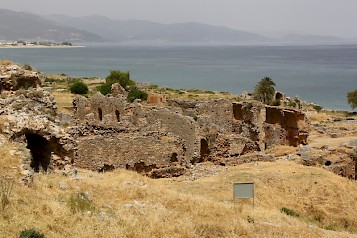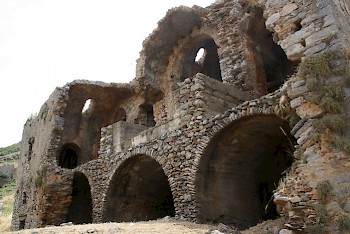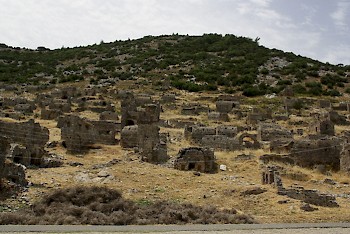Anemurium (Anamur)
Q529237Anemurium (Greek Ανεμούριον): city in the Roman province of Cilicia, built on a promontory with the same name.
Early History

Anemurium is situated near a steep promontory with the same name,note directly opposite Cyprus, which is just sixty-four kilometers away and is visible from the Taurus mountains in Anemurium’s hinterland.note This city was situated on the ancient road along the coast of Rough Cilicia (Cilicia Tracheia).
The origins of Anemurium, which consists of a citadel on the promontory and a lower city just north of it, are not well-known but the Roman historian Livy tells us that in 197 BCE, during the Fifth Syrian War, the Seleucid king Antiochus III the Great captured the city.note Stones from this period are still visible in the citadel.
After c.110, Seleucid power was in decline and the inhabitants of Rough Cilicia started to behave as pirates. Because the Cilician Pirates sold the slaves that the ancient economy could not do without, the Seleucid and Roman authorities hesitated and did not act immediately. In 78-74, however, Roman general Publius Servilius Vatia subdued western Cilicia. The last Cilician war was conducted by Marcus Tullius Cicero (51-50), who defeated the remaining independent Cilicians.
Roman city

Cilicia was now converted into a province, but Anemurium somehow remained part of Commagene, until this small kingdom was finally absorbed into the Roman Empire in 72 CE. Anemurium became the center of the Roman local administration, from which the governor controlled a section of the Cilician shore.
A mint was created during the reign of the emperor Caligula (r.37-41) and would continue to operate until the reign of Valerian (r.253-260). The Roman historian Tacitus records troubles with a local tribe, the Isaurian Cietae, who were commanded by a man named Troxobor, took the city in 52 CE, and were finally expelled by a small army from Syria.note
Many buildings, still visible today, document that Anemurium was a wealthy town. At least four bathhouses have been identified. Its prosperity made this a logical target for Persian aggression. During the crisis of 260 CE, the Sasanian king Shapur captured the city and inaugurated a period of political instability. The Isaurians raided the coastal area. Large public buildings were abandoned and transformed into housing or workshops for producing goods, such as lamps and pottery.
Late Antiquity

In 382, an official named Matronian (whose name is mentioned in an inscription) responded to another Isaurian attack by improving the walls of the citadel, where he placed a garrison that would defend the town against future raids. Safe again, the city flourished in Late Antiquity.
There were several churches, like the Necropolis Church and at least three sixth-century churches. The archbishop of Seleucia on the Calycadnus (modern Silifke) appointed the bishop; we know that one James of Anemurium attended the Council of Chalcedon in 451.
In 580 CE, an earthquake severely damaged Anemurium. The Arab conquest of Cyprus in 649 made the city indefensible and the site was abandoned for several centuries. During the age of the Crusades, however, the walls of the Late Roman castle were rebuilt. The buildings inside this new fortress, called Mamure, were made from Hellenistic stones. Part of the Armenian kingdom of Cilicia, Mamure shared in its fate and was captured by the Turks in 1221.
 Anemurium, Necropolis |
 Anemurium, Aqueduct |
 Anemurium, Odeon |
 Anemurium, Necropolis |
Remains

The ruins of Anemurium extend over a large area, about 1500 meters long and 400 meters wide, from the beach to a steep mountain slope, which is partly covered with hundreds of Roman tombs. An intact city wall is its western boundary.
Some tombs are large, house-like structures with niches, where relatives of the deceased could pay their respect while feasting. A few tombs contain ancient funerary paintings and mosaics. Most extant structures are made of concrete and date from the second and third centuries, when Anemurium achieved its greatest prosperity.
Among the preserved public buildings are a large theater (twenty-six rows; 2700 seats), a small odeon, a large three-aisled civil basilica, and three or four impressive public baths. The largest bathhouse, a two-story vaulted roof structure up on the slope, is well preserved with intact mosaics, as well as changing rooms. It received its waters from an aqueduct.
 Anemurium, Baths |
 Anemurium, Baths |
 Anemurium, Baths |
 Anemurium, Baths |
Getting there
The ancient site of Anemurium is well signposted on the main road 400 leading from Gazipaşa to Anamur at the entrance of the modern city. Take at least two hours for a visit.